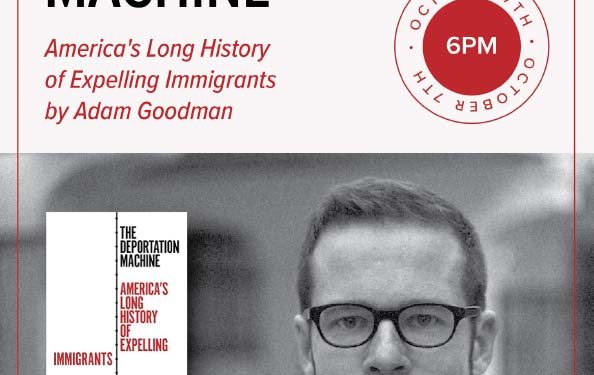The United States of America is commonly known for the following ideas: the Grand Canyon, apple pie and Mount Rushmore. But, what you might not know is that the U.S. is also known for having a deportation machine problem.
In his book, “The Deportation Machine: America’s Long History of Expelling Immigrants,” professor and author Adam Goodman writes about America’s extensive history of expelling immigrants.
On his personal website, Goodman describes the focus of his book.
“It traces the US government’s systematic efforts to terrorize and expel noncitizens over the past 140 years,” his website reads. “I uncover public officials’ use of force, coercion, and fear to purge immigrants from the country and exert control over those who remain. The book introduces the politicians, bureaucrats, businesspeople, and ordinary citizens who have pushed for and profited from expulsion. It chronicles the devastating human costs of punitive enforcement policies and the innovative strategies people have adopted to fight against removal and redefine belonging in ways that transcend citizenship.”
In an effort to promote his book, the Office of Diversity and Intercultural Initiatives at Samford, the University of Alabama at Birmingham, the Department of Division of Diversity, Equity and Inclusion at the University of Alabama, as well as the Hispanic Interest Coalition of Alabama held a virtual webinar on Oct. 7 from 6 p.m.-7:30 p.m.
Director of Diversity Education and Development Jenée Spencer discussed the importance of the webinar and what she hoped attendants got out of it.
“I hope that those in attendance had the opportunity to gain understanding about the nuanced challenges many people in this country face. Perspective-taking is a key aspect of empathy and when we empathize, we can advocate,” Spencer said.
On the webinar, Goodman provided further information on his book and the concept of the deportation machine.
He explained how the U.S. government has historically expelled immigrants in three methods.
“Since the 1890s, when the U.S federal government gained control over immigration and the creation of the immigration bureaucracy in 1891, they have used three different mechanisms of expulsion to remove people from the country,” Goodman said. “One is the so-called formal deportations, which have historically happened by order of an immigration judge.”
The second and third methods are forms of self-deportations, but neither is typically completely voluntary.
“Another is euphemistically known as voluntary departure, these were administrative expulsions that happened after someone was apprehended by an immigration official, and the official encouraged, coerced or tricked the person into signing legal documents waiving their rights saying that they would leave the country on their own, even though they were not doing so out of their own choice,” Goodman said “The third mechanism is self-deportations, this is when immigration agents enact fear campaigns or violence that make migrants’ lives difficult. The idea here is to make their lives so miserable that they leave without ever coming into contact with an immigration official.”
Goodman also discussed how certain racial groups were targeted at different times in history because the United States has always depended on immigrant labor and who has served the country’s need for labor has changed over time.
“In my book, I show the targeting of Chinese labor migrants in the late 19th Century who were instrumental in building the transcontinental railroad and the Southern Eastern Europeans were also targeted around the turn of the 20th Century,” Goodman said. “But after restrictive immigration acts limiting the migration of people from Asia and southern eastern Europe, U.S. employers started to turn to Mexican migrants for labor but Mexican migrants also became the target of U.S. immigration officials’ efforts of deportation.”
According to Goodman, the deportation or targeting of Mexican immigrants has led to the stereotyping of the entire group being seen as “prototypical illegal aliens.” And in turn, these stereotypes have allowed immigration officials to justify their treatment of Mexican immigrants.
This virtual webinar was one of many events put on by the Office of Diversity and Intercultural Initiatives at Samford to honor Hispanic Heritage Month, which took place from Sept.15-Oct.15.
Spencer shared some opportunities for what non-Hispanic individuals can do to properly support the Hispanic community.
“Support the Latino Student Union by joining and/or attending their events. Get involved with groups that work diligently to support the Latino community such as HICA, Adelante Alabama, and many others,” Spencer said. “Last, work to understand systems that perpetuate inequities affecting Latino communities and how you can use your access, whatever that may be, to make lasting and effective change.”
However, in order to create effective change, individuals must understand the systemic racism that has been perpetuated for a long period of time against specific groups such as immigrants.
Goodman’s book helps to shed light on the reality that immigrants have faced and are facing in America.
To order a copy of Goodman’s book, visit Amazon.com or your preferred bookstore.

Staff Writer






